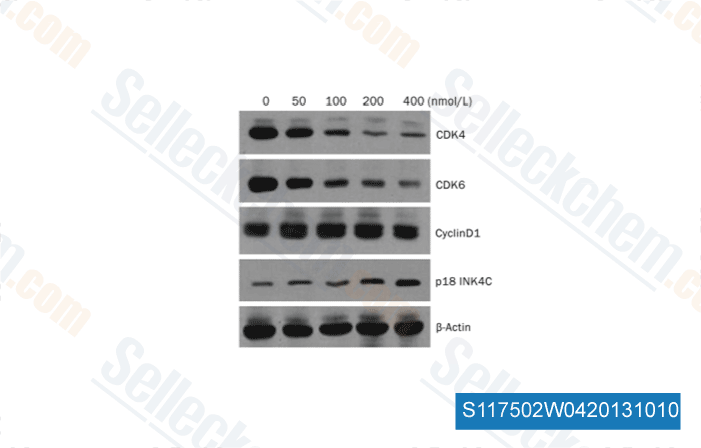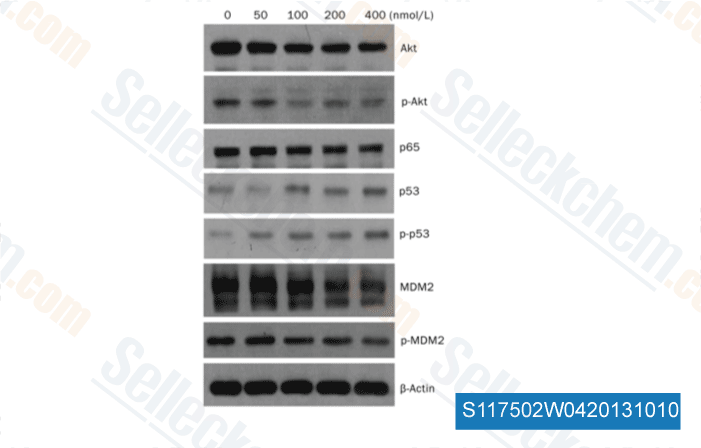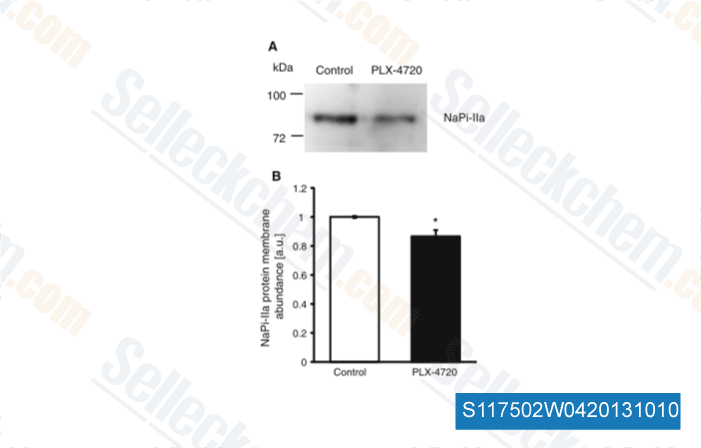|
Toll Free: (877) 796-6397 -- USA and Canada only -- |
Fax: +1-832-582-8590 Orders: +1-832-582-8158 |
Tech Support: +1-832-582-8158 Ext:3 Please provide your Order Number in the email. |
Technical Data
| Formula | C14H15ClN6O |
||||||
| Molecular Weight | 318.76 | CAS No. | 848695-25-0 | ||||
| Solubility (25°C)* | In vitro | DMSO | 64 mg/mL (200.77 mM) | ||||
| Ethanol | 12 mg/mL (37.64 mM) | ||||||
| Water | Insoluble | ||||||
| In vivo (Add solvents to the product individually and in order) |
|
||||||
|
* <1 mg/ml means slightly soluble or insoluble. * Please note that Selleck tests the solubility of all compounds in-house, and the actual solubility may differ slightly from published values. This is normal and is due to slight batch-to-batch variations. * Room temperature shipping (Stability testing shows this product can be shipped without any cooling measures.) |
|||||||
Preparing Stock Solutions
Biological Activity
| Description | BIIB021 (CNF2024) is an orally available, fully synthetic small-molecule inhibitor of HSP90 with Ki and EC50 of 1.7 nM and 38 nM, respectively. Phase 2. | ||
|---|---|---|---|
| Targets |
|
||
| In vitro | BIIB021 binds in the ATP-binding pocket of Hsp90, interferes with Hsp90 chaperone function, and results in client protein degradation and tumor growth inhibition. BIIB021 inhibits tumor cell (BT474, MCF-7, N87, HT29, H1650, H1299, H69 and H82) proliferation with IC50 from 0.06-0.31 μM. BIIB021 induces the degradation of Hsp90 client proteins including HER-2, Akt, and Raf-1 and up-regulated expression of the heat shock proteins Hsp70 and Hsp27. [1] BIIB021 inhibits Hodgkin's lymphoma cells (KM-H2, L428, L540, L540cy, L591, L1236 and DEV) with IC50 from 0.24-0.8 μM. BIIB021 shows low activity in lymphocytes from healthy individuals. BIIB021 inhibits the constitutive activity of NF-κB despite defective IκB. BIIB021 induces the expression of ligands for the activating NK cell receptor NKG2D on Hodgkin's lymphoma cells resulting in an increased susceptibility to NK cell–mediated killing. [2] BIIB021 enhanced the in vitro radiosensitivity of HNSCCA cell lines (UM11B and JHU12) with a corresponding reduction in the expression of key radioresponsive proteins, increased apoptotic cells and enhance G2 arrest. [3] BIIB021 is considerably more active than 17-AAG against adrenocortical carcinoma H295R, both in vitro and in vivo. The cytotoxic activity of BIIB021 is not influenced by loss of NQO1 or Bcl-2 overexpression, molecular lesions that do not prevent client loss but are nonetheless associated with reduced cell killing by 17-AAG. BIIB021 is also active in 17-AAG resistant cell lines (NIH-H69, MES SA Dx5, NCI-ADR-RES, Nalm6 and etc.). [4] | ||
| In vivo | Oral administration of BIIB021 leads to tumor growth inhibition in many tumor xenograft models including N87, BT474, CWR22, U87, SKOV3 and Panc-1. [1] BIIB021 effectively inhibits growth of L540cy tumor at a dose of 120 mg/kg. [2] BIIB021 significantly enhances antitumor growth effect of radiation in JHU12 xenograft. [3] |
Protocol (from reference)
| Kinase Assay:[1] |
|
|---|---|
| Cell Assay:[1] |
|
| Animal Study:[1] |
|
References
Customer Product Validation

-
Data from [Acta Pharmacol Sin, 2013, 34(12), 1545-53]

-
Data from [Acta Pharmacol Sin, 2013, 34(12), 1545-53]

-
Data from [Acta Pharmacol Sin, 2013, 34(12), 1545-53]

-
Data from [Acta Pharmacol Sin, 2013, 34(12), 1545-53]
Selleck's BIIB021 has been cited by 33 publications
| A novel PET probe to selectively image heat shock protein 90α/β isoforms in the brain [ EJNMMI Radiopharm Chem, 2024, 9(1):19] | PubMed: 38436869 |
| m6A modification confers thermal vulnerability to HPV E7 oncotranscripts via reverse regulation of its reader protein IGF2BP1 upon heat stress [ Cell Rep, 2022, 41(4):111546] | PubMed: 36288717 |
| deepOrganoid: A brightfield cell viability model for screening matrix-embedded organoids [ SLAS Discov, 2022, 27(3):175-184] | PubMed: 35314378 |
| The Disassociation of the A20/HSP90 Complex via Downregulation of HSP90 Restores the Effect of A20 Enhancing the Sensitivity of Hepatocellular Carcinoma Cells to Molecular Targeted Agents [ Front Oncol, 2021, 11:804412] | PubMed: 34976842 |
| Heat Shock Protein 90 Triggers Multi-Drug Resistance of Ovarian Cancer via AKT/GSK3β/β-Catenin Signaling [ Front Oncol, 2021, 11:620907] | PubMed: 33738259 |
| HSP90 Inhibitor, NVP-AUY922, Improves Myelination in Vitro and Supports the Maintenance of Myelinated Axons in Neuropathic Mice. [ ACS Chem Neurosci, 2019, 10(6):2890-2902] | PubMed: 31017387 |
| Mutation Profiles in Glioblastoma 3D Oncospheres Modulate Drug Efficacy. [ SLAS Technol, 2019, 24(1):28-40] | PubMed: 30289729 |
| Targeting CDK2 overcomes melanoma resistance against BRAF and Hsp90 inhibitors [ Mol Syst Biol, 2018, 14(3):e7858] | PubMed: 29507054 |
| ATM Is Required for the Prolactin-Induced HSP90-Mediated Increase in Cellular Viability and Clonogenic Growth After DNA Damage. [Karayazi Atici, et al. Endocrinology, 2018, 159(2):907-930] | PubMed: 29186352 |
| The Toxmatrix: Chemo-Genomic Profiling Identifies Interactions That Reveal Mechanisms of Toxicity [ Chem Res Toxicol, 2018, 31(2):127-136] | PubMed: 29156121 |
RETURN POLICY
Selleck Chemical’s Unconditional Return Policy ensures a smooth online shopping experience for our customers. If you are in any way unsatisfied with your purchase, you may return any item(s) within 7 days of receiving it. In the event of product quality issues, either protocol related or product related problems, you may return any item(s) within 365 days from the original purchase date. Please follow the instructions below when returning products.
SHIPPING AND STORAGE
Selleck products are transported at room temperature. If you receive the product at room temperature, please rest assured, the Selleck Quality Inspection Department has conducted experiments to verify that the normal temperature placement of one month will not affect the biological activity of powder products. After collecting, please store the product according to the requirements described in the datasheet. Most Selleck products are stable under the recommended conditions.
NOT FOR HUMAN, VETERINARY DIAGNOSTIC OR THERAPEUTIC USE.
